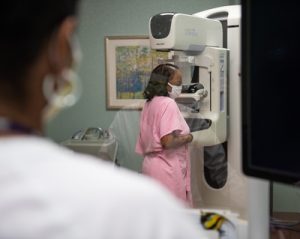By Gina DiPietro, Novant Health Healthy Headlines
To find and book a physician click here.
Breast cancer, the second leading cause of cancer death in women, kills tens of thousands of people each year, according to the American Cancer Society.
This underscores the importance of regular mammograms, as outcomes are better when cancer is detected and treated early. Novant Health recommends that asymptomatic women with an average risk of breast cancer start receiving an annual mammogram once they turn 40.
The life-saving screening may begin before age 40 for women at higher risk, including those with a personal or family history of breast cancer. And people who fall into this category should consider getting a 3-D mammogram, said Dr. Adam Braithwaite, a radiologist with Delaney Radiology and director of breast imaging at Novant Health Brunswick Medical Center.
Women with “dense breasts” can also benefit from 3-D mammography, Braithwaite said. Here’s why: Studies show 3-D mammograms are more likely to find small, invasive breast cancers – especially in women younger than 50 – compared to breast cancers found with standard digital mammography.
What does it mean to have dense breasts?
Contrary to popular belief, what constitutes “dense breasts” has nothing to do with breast size. Breast tissue is made of both fatty tissue and glandular tissue, the latter of which causes the density.
“When you have dense breast tissue, it can be difficult to see little masses or things hiding within the dense tissue,” Braithwaite said. “3-D mammography allows us to look through the entire breast and detect more cases of cancer.”
Women with dense breasts have a higher risk of getting breast cancer, the Centers for Disease Control and Prevention reports, though breast cancer patients who have dense breasts are not more likely to die from breast cancer than those who do not.
How does a regular mammogram differ from one that’s 3-D?
 A 3-D mammogram, also known as tomosynthesis, allows a woman’s breast to be imaged from multiple angles.
A 3-D mammogram, also known as tomosynthesis, allows a woman’s breast to be imaged from multiple angles.
“In the past, a standard image would be two images of each breast. With the 3-D mammogram, the procedure is the same, but the camera rotates and takes multiple photos so we get a seamless view of the breast, Braithwaite said.
The angled images provide 1-millimeter-thin snapshots of the breast tissue that, collectively, provide radiologists a more detailed, three-dimensional view than standard, two-dimensional mammograms. It enables providers to have better visibility and more accurately detect cases of breast cancer.
“3-D mammograms help us detect small cancers, little masses or areas of distortion, that we otherwise could have missed,” Braithwaite said. “It also reduces call backs and anxiety for patients.”
Most women won’t notice the difference between a 3-D mammogram and a standard digital mammogram.
“The examination itself is almost identical for patients,” Braithwaite said. “It just takes about four seconds longer per view.”
During a 3-D mammogram, an X-ray tube moves in an arc over the patient and takes multiple low-dose images that are regenerated by a computer. After 3-D imaging is complete, the machine will move back to the center and take the regular two-dimensional, or standard, mammogram pictures.
COVID-19 vaccines and mammograms
An important reminder from the Society of Breast Imaging is that women should consider timing their mammogram around the COVID-19 vaccines. That’s because vaccines can cause temporary swelling of the lymph nodes, which Braithwaite said could distort the results of a mammogram.
Patients are encouraged to schedule their mammogram six weeks after the second COVID vaccine dose (or before the first dose) to avoid an unnecessary follow-up visit. Read this story to better understand why.
Please note, if you or your healthcare provider have a breast-related concern, do not delay getting your diagnostic exam. Now is the best time.
Schedule yours today. It’s easy.
If you think a 3-D mammogram is right for you, speak with your doctor or simply request one when you make an appointment.
For a list of Novant Health locations that offer 3-D mammograms, click here. Depending on your insurance plan, keep in mind that additional fees may apply.
If your doctor recommends a standard mammogram, here is a complete list of all Novant Health breast imaging locations.
Need financial assistance?
Many Novant Health facilities have support from grant programs to help cover the cost of mammograms for uninsured patients. Please call us to see if you qualify:
– Greater Charlotte area: 704-384-5250; en espanol: 704-384-8202
– Triad area: 336-397-6017
Warning signs of breast cancer
Different people have different symptoms of breast cancer. Some people do not have any signs or symptoms at all. Warning signs can include:
– New lump in the breast or underarm (armpit).
– Thickening or swelling of part of the breast.
– Irritation or dimpling of breast skin.
– Redness or flaky skin in the nipple area or the breast.
– Pulling in of the nipple or pain in the nipple area.
– Nipple discharge other than breast milk, including blood.
– Any change in the size or the shape of the breast.
– Pain in any area of the breast.
Keep in mind that these symptoms can happen with other conditions that are not cancer. If you have any signs or symptoms that worry you, be sure to see your doctor right away.
Novant Health
Healthy Headlines
Facebook
Instagram
Twitter
YouTube




